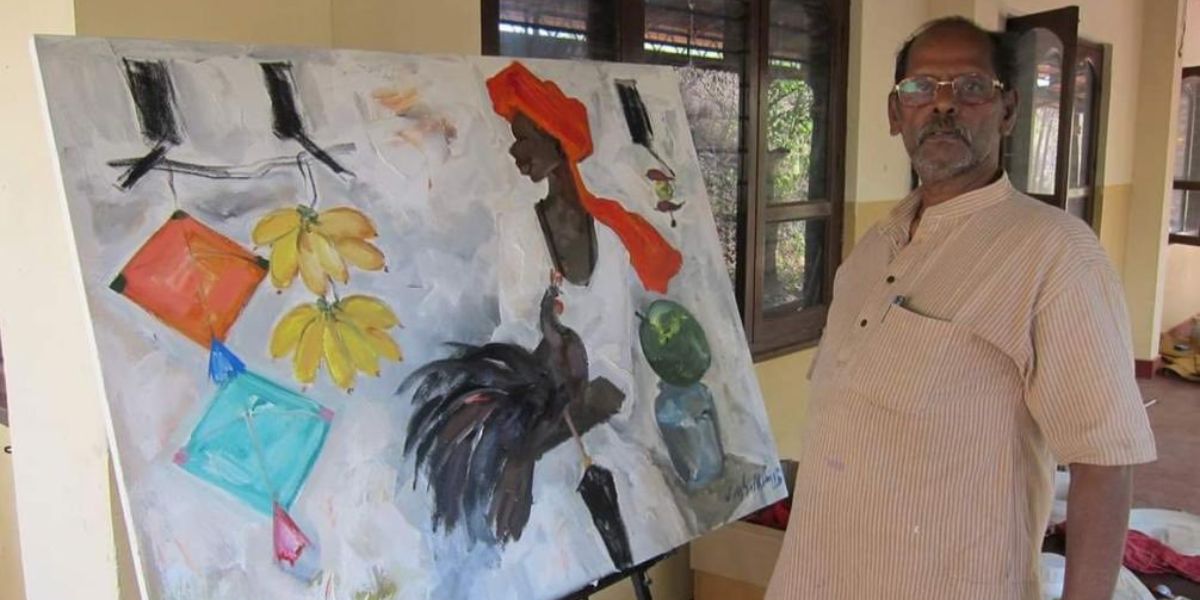Mani held his first exhibition in a bus garage at the Bangalore University campus and it was during that show he realised art was his life.

There’s a joke that Karnataka’s artists like to share about the late artist JM Subramani, popularly known as JMS Mani, who passed away in June 2021.
Just as the Berlin Wall would at least be twice its original length if all the sold wall pieces were put together, Mani’s Badami series has more people in it than Badami has.
Such is the price of popularity that his latest retrospective, being held in Kynkyny Art Gallery in Bengaluru till 30 June, which wants to show the world his influences, has no choice but to start with Badami.
“That series was so popular that he made more than 10,000 paintings on it. He has been visiting that town for 40 years, inspired by its natural beauty and colours. The town famous for its rock-cut monuments, is situated in the Bagalkot district of Karnataka,” said Joobi Yohannan, an independent art consultant who curated a retrospective show of Mani in July 2018 for Bengaluru-based art gallery, Time and Space.
But Mani was much more than just Badami, insisted artist Shirley Mathew, who studied at Ken School of Art in Bengaluru when Mani was the principal there. Three months before his death, in February 2021, Mathew’s gallery, MKF Museum of Art, had held, what she calls a “mini retrospective”‘ of his work.
“People got stuck on Badami and since Mani was from a poorer background and his family depended a lot on him, he kept indulging them. But his heart was in abstraction and he was really good in it,” said Mathew.
Art historian Pramila Lachan said at one point Mani took up odd jobs like painting signboards for shops, designing posters for political parties, painting walls and carpentry to keep him going.
It was only after he came across RM Hadapad, who was heading the Ken School of Art at that time, his life took a turn.
“Mani’s tryst with Ken began in 1973 when he came across Hadapad teaching the rudiments of plaster mould to a group of students. When Mani expressed his desire to join the college, Hadpad, immediately asked him to come the following day,” added Lachlan.
According to her, Mani held his first exhibition in a bus garage at the Bangalore University campus and it was during that show he realised art was his life.
Despite his struggles and even after he got famous Mani was adamant that his paintings are priced in the affordable range.
“He was very prolific and his works would fly off the wall. But he consciously decided to price his works in the affordable range as he wanted them to be bought by more people,” said Yohannan.
Mathew recalled an incident narrated by the artist to her when she was researching for his retrospective. “Mani told me that he once asked a client to go shopping nearby and come back after an hour. In the meantime, he finished three paintings for him. The other artist who was as prolific as him was Yusuf Arakal,” added Mathew.
But according to her, putting together his influences chronologically was a difficult task since he did not document all his work. “For instance, not many are aware or have seen his erotica art,” she said.
His latest show, Badami and Beyond at Kynkyny Gallery tries to piece the puzzle called Mani together by showcasing his experiments with several mediums and styles, from sketches to landscapes and impressionistic and surreal artworks.
It is true that Badami catches the eye instantly. But if we look past the yellow of the bananas, almost his signature in his Badami series, it is possible to see the other influences and physical spaces that surrounded him, creating archetypes of mountains, trees, monuments, and Hampi’s landscapes.
Lachan said his paintings are often his spontaneous response to situations, locations or people around him.
Thanks to his Badami series, his impasto technique (wherein a blob of paint is flattened by a knife to desired shape) and the interesting texture he derived through it, were much admired.
But he was equally adept in merging the thick bold strokes of his charcoal drawings into dreamy puddles of watercolours in the same painting.
“He made interesting works by making a collage of labels of burst crackers. He did not hesitate to use materials that are often discarded as waste by others,” said Yohannan.
Bengaluru-based artist Ravikumar Kashi, who also studied under him at Ken School of Art between 1982 and 1985, agreed that Mani was very good at exploring new materials. “He experimented with printmaking and glass blowing. In those days, we did not have easy access to proper materials as well as tools for printmaking. So, he taught us to adapt jewellery engraving tools,” said Kashi.
Kashi also said Mani belonged to the generation of artists that believed in the maxim “Don’t think, just paint”.
“For them, painting is a visceral activity. Post-1990s, for many of us it was natural to think politically to express ourselves. Mani was moulded by a pre-90s school of thought. While visceral thinking made working fluid, it was also possible to become repetitive. In those days, there was also more market pressure, so repetitiveness became unavoidable,” added Kashi.

Jul 27, 2024

Jul 26, 2024

Jul 26, 2024

Jul 26, 2024

Jul 26, 2024

Jul 26, 2024